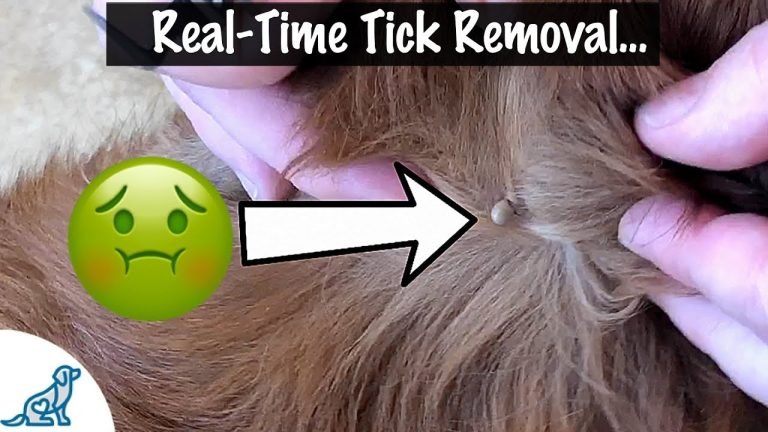Identifying Tick Eggs on Dogs: A Visual Guide

Have you ever wondered what tick eggs look like on a dog? These tiny parasites can cause big problems for our furry friends, so it's important to know what to look for. In this article, we'll explore the appearance of tick eggs and how to spot them on your dog's fur. By the end, you'll have a better understanding of how to protect your pet from these pesky pests.
How can you tell if a tick has laid eggs?
If you're worried about whether a tick has laid eggs, look for tick egg nests, which are easier to spot than the ticks themselves. These batches of eggs are often brown and red in color and appear translucent. Even though ticks are small, they can lay thousands of eggs, but the eggs are not infectious at this stage.
How can tick eggs be killed?
Did you know that submerging tick eggs into rubbing alcohol is an effective way to kill them? Be sure to take proper safety precautions, such as wearing gloves, when attempting this method. Keep your home and pets safe from ticks by using this simple and efficient solution.
What is the appearance of an embedded tick on a dog?
An embedded tick on a dog is typically oval shaped, firm, and dark red or brown, with no hairs growing out of it. This contrasts with moles and skin tags, which are irregular, soft, and lighter in color. Additionally, ticks tend to settle in the dog's skin folds, facial or groin area, or abdomen, while moles usually appear on the face and back.
Spotting Tick Eggs: A Comprehensive Guide
Spotting tick eggs can be a challenging task, but with the right knowledge and awareness, you can effectively identify these tiny pests. Tick eggs are typically laid in clusters, resembling small, dark specks or grains of sand. They can be found in damp, wooded areas and are often hidden in tall grass or shrubs. To spot tick eggs, carefully inspect your body and clothing after spending time outdoors, paying close attention to areas such as the scalp, armpits, and groin. By being vigilant and knowing where to look, you can successfully identify and remove tick eggs, reducing the risk of tick-borne illnesses.
Tick Eggs Demystified: A Visual Handbook
Tick Eggs Demystified: A Visual Handbook is your ultimate guide to understanding the life cycle of ticks. Ticks are small arachnids that can transmit diseases to humans and animals, making it crucial to understand their biology and behavior. This visual handbook provides clear and concise information about tick eggs, offering a comprehensive look at their development and how to prevent infestations.
The visual aspect of Tick Eggs Demystified: A Visual Handbook allows for easy comprehension of complex biological processes. With detailed illustrations and diagrams, readers can easily grasp the various stages of tick egg development and learn how to identify and remove them from their environment. This handbook is a valuable resource for anyone looking to protect themselves and their loved ones from tick-borne illnesses.
Whether you're a hiker, pet owner, or outdoor enthusiast, Tick Eggs Demystified: A Visual Handbook is an essential tool for understanding and preventing tick infestations. By educating yourself on the life cycle of ticks and their eggs, you can take proactive steps to minimize the risk of exposure and keep yourself and your family safe. With its visually engaging content, this handbook is a must-have for anyone seeking to demystify the world of tick eggs.
Unveiling Tick Eggs: A Practical Guide for Dog Owners
As a dog owner, it's important to be aware of the presence of tick eggs and how to effectively manage them. Ticks can lay hundreds to thousands of eggs at a time, which can lead to a serious infestation if not addressed promptly. Understanding the life cycle of ticks and how to identify their eggs can help you take proactive measures to protect your furry friend from these pesky parasites.
The first step in managing tick eggs is to regularly inspect your dog for any signs of infestation. This includes thoroughly checking their fur, especially in areas where ticks are known to hide, such as around the ears, neck, and between the toes. If you spot any tick eggs, carefully remove them using a fine-toothed comb or specialized tick removal tool. It's also crucial to keep your dog's living environment clean and well-maintained to prevent ticks from laying eggs in the first place.
In addition to regular inspections, using preventative measures such as tick repellent products and keeping your dog away from tick-infested areas can help minimize the risk of infestation. By staying informed and proactive, you can effectively manage tick eggs and ensure the well-being of your beloved pet.
Tick Eggs Exposed: A Visual Reference for Pet Owners
Discover the hidden world of tick eggs with this comprehensive visual reference for pet owners. From the microscopic details to the life cycle of these pesky parasites, this guide provides a clear and concise overview of what to look for and how to prevent infestations. With detailed images and helpful tips, you'll be equipped to protect your furry friends from the dangers of tick eggs. Keep your pets safe and informed with this essential resource.
In conclusion, understanding what tick eggs look like on a dog is crucial for effective prevention and treatment. By being able to identify these tiny, often overlooked eggs, pet owners can take the necessary steps to protect their furry companions from potentially harmful tick infestations. Regular grooming, using tick prevention products, and keeping outdoor areas tidy can all help in keeping dogs safe from these pesky parasites. By staying informed and proactive, pet owners can ensure their dogs remain healthy and happy, free from the threat of tick-borne diseases.
